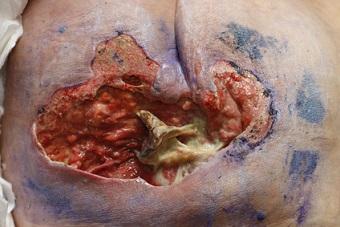Refractory Wounds: Systemic Factors Affecting Repair – Iatrogenic Factors (Part 4 of 4)
July 28, 2021
Refractory wounds comprise a significant worldwide health problem, affecting 5 to 7 million people per year in the United States alone, as discussed in previous blogs (Part 1, Part 2, Part 3). Wounds that fail to heal not only impact quality of life, but also impose a significant physical, psychosocial, and financial burden. Additionally, individuals with refractory wounds often experience significant morbidity, and sometimes mortality. Wound infections and amputations are common in this population, and chronic conditions often exist as well.1
In the past three blogs, I discussed refractory wounds in depth, including assessment and management of these non-healing wounds. Additionally, I identified and discussed intrinsic and extrinsic factors as they relate systemically to a stalled or refractory wound. In the most recent blog in this series, local factors preventing repair (iatrogenic factors) were presented with specific examples as they relate to the healing process. In this blog, I focus on the final factor affecting tissue repair in refractory wounds: adherence.
Adherence
Adherence is a concept that stretches well beyond a patient’s own motivation to heal their wound or follow their recommended treatment plan. Adherence encompasses many aspects of care, from psychological factors, finances, comprehension or health literacy, and physical abilities to access to care. Additionally, effective wound outcomes and healing require a patient-centered approach and frequent assessment and communication with the patient and care team, along with a clearly established and updated holistic plan of care.1
Financial Factors
Managing refractory wounds includes modifications of many aspects of our patient’s lives. The financial aspect here is both societal and personal. Missed work, the cost of topical treatments or wound products, medications, and the impact of underinsurance or lack of insurance all greatly impact the ability to provide proper wound management.1
Life
As we all know, sometimes life throws us a curveball. There are unexpected and expected turns in life that may impact healing with a chronic wound. Life commitments include caring for family members, providing for family, attending family functions, performing household chores, and engaging in personal hobbies, and they may result in competing priorities with the plan of care.
Comprehension
The patient’s ability to understand the treatment plan has a huge impact on the success of the treatment plan. Health literacy and culture may also come into play here. Using the teach-back method can be helpful when discussing a treatment plan, by making sure that the patient understands the rationale behind the prescribed or recommended treatment. Again, the plan should be patient-centered and specific, including frequent collaboration with the patient related to progress or challenges.
Patient adherence to the plan of care is greatly impacted by their perception of the advantages and disadvantages of the behaviors they are being asked to adopt into their lifestyle and routine. Their level of comprehension should be assessed initially and then reassessed at each follow-up visit, thus ensuring that the patient and clinician are on the same page, and goals related to wound healing are clear.1
Psychosocial Factors
Psychosocial aspects of refractory wounds and healing include attitudes, beliefs, expectations, and cultural issues. Understanding the patient’s baseline, goals, and health literacy is important. Explaining things in terms that the patient understands is critical to forming a therapeutic relationship and building trust. Understanding how culture may impact wound care or products used in wound care is also a critical element in the plan of care.1
Accessibility
It is imperative for clinicians to recommend wound care products that are not only appropriate but also accessible to the patient. If products are recommended that may not be covered by insurance or are too expensive, the patient may be unable to follow this recommended treatment plan. When devising the initial plan of care, the clinician and the patient should determine the best options together, ensuring that access to necessary supplies and care is addressed.
Differing Goals
As discussed in previous blogs, wound healing may not always be the goal. It is important to identify the goal in discussions between the patient and clinician and to outline responsibilities related to healing clearly . For example, if healing is the goal for an ischial wound, there may be recommendations for bedfast status or a limited time spent up in the chair. These expectations should be communicated clearly between the patient and clinician to be sure that all aspects of a holistic plan of care are clear between both parties.
Conclusion
It is important to piece together all of the systemic factors impacting healing when looking at reasons why a wound is not improving within two to four weeks of evidence-based topical therapy and a comprehensive, holistic plan of care. Looking at the four local factors preventing repair is an important part of the treatment plan, especially when revising the plan of care. Many variables have been discussed in these last several blogs, and many really just touch on the tip of the iceberg. A holistic, patient-centered approach is a critical element in any care plan, along with close follow-up and routine assessment of the wound and related variables. Understanding the etiology of the wound and the reasons for a lack of improvement are important concepts in care plan revision and follow-up.
Reference
1. Netsch DS. Refractory wounds: assessment and management. In: Doughty DB, McNichol LL, eds. WOCN Society Core Curriculum: Wound Management. Philadelphia, PA: Wolters Kluwer; 2016:181-197.
About the Author
Holly is a board certified gerontological nurse and advanced practice wound, ostomy, and continence nurse coordinator at The Department of Veterans Affairs Medical Center in Cleveland, Ohio. She has a passion for education, teaching, and our veterans. Holly has been practicing in WOC nursing for approximately six years. She has much experience with the long-term care population and chronic wounds as well as pressure injuries, diabetic ulcers, venous and arterial wounds, surgical wounds, radiation dermatitis, and wounds requiring advanced wound therapy for healing. Holly enjoys teaching new nurses about wound care and, most importantly, pressure injury prevention. She enjoys working with each patient to come up with an individualized plan of care based on their needs and overall medical situation. She values the importance of taking an interprofessional approach with wound care and prevention overall, and involves each member of the health care team as much as possible. She also values the significance of the support of leadership within her facility and the overall impact of great teamwork for positive outcomes.
The views and opinions expressed in this blog are solely those of the author, and do not represent the views of WoundSource, HMP Global, its affiliates, or subsidiary companies.












Follow WoundSource
Tweets by WoundSource